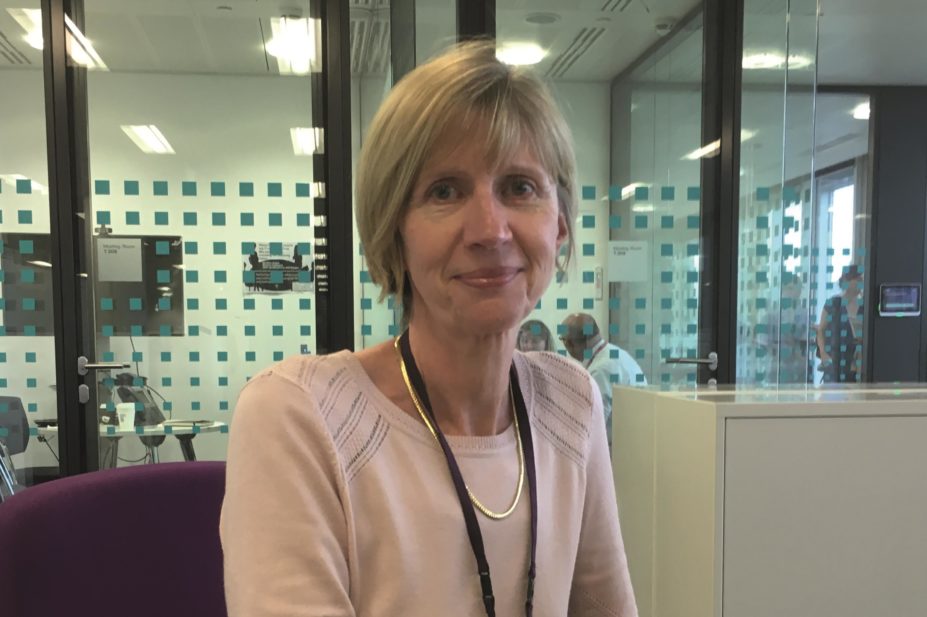
Julia Robinson / The Pharmaceutical Journal
When it comes to pharmacy, Sarah Billington, head of medicines optimisation at the Care Quality Commission (CQC) — the independent regulator of all health and social care services in England — has pretty much done it all. “I started my career as a hospital pharmacist but I’ve had the opportunity to work in all the main sectors that pharmacists work in, bar industry – community pharmacy, medicines information, hospital management, regulation. I’ve done it in the NHS, I’ve done it in the private sector, I’ve done it in this country and I’ve done it overseas.”
But it has been curiosity, rather than dissatisfaction, with each of her previous roles that led her to wonder, “what else can I do?”.
Helping improve knowledge of medicines optimisation
Some 13 years after she took the first step from clinical pharmacy to healthcare regulation, Billington’s unusual combination of skills and experience has landed her the role of head of medicines optimisation at the CQC.
Leading a field-based team of 40 people, Billington’s role is a mixture of operations, strategy, stakeholder engagement and working with other organisations with the common purpose of improving the safety and quality of care across England and promoting understanding of the impact of medicines on patient outcomes.
“Everything we do is around getting a better deal for patients through better use of their medicines and improving everyone’s awareness of medicines optimisation,” she explains. “A lot of my time is spent working with a wide range of stakeholders: people in the CQC who know about medicines but don’t fully understand medicines optimisation; national organisations; and healthcare providers who want to know how they can meet the fundamental standards.”
She adds: “I’ve got experience of delivering services in healthcare and experience of regulating services. It is critical to have that understanding of medicines and the impact they have on people in order to do this job.”
But it is important that Billington’s team also has a diverse skill mix, from experts in mental health and substance misuse to people from community pharmacy and clinical commissioning group backgrounds. “Recently, we employed our first three pharmacy technicians because we need to make sure that we draw upon the breadth of the pharmacy profession,” says Billington. “We, as a medicines team, work slightly differently from every other team because we work across the sectors. The team use their skills in a particular sector but also do a generic role as well — we multitask!” she quips.
The team covers all the different directorates from adult social care, nursing homes and domiciliary care, to primary care, out-of-hours services, mental health services and entire hospital trusts. “We’re everywhere and we’ve got to get the right support where it needs to be. A lot of my job is targeting that resource [the team] and making sure we use it to best effect.”
What does it take to pass a CQC inspection?
In order to ascertain if a healthcare provider meets the fundamental standards, the CQC inspection team asks five questions: “Is it safe? Is it effective? Is it caring? Is it well led? And is it responsive? No matter how diverse they are we still ask those five questions.” explains Billington. “Medicines specifically are found in the safety domain — however, the principles of medicines optimisation are threaded through all the domains,” she adds.
According to Billington, healthcare providers generally do best in the caring domain. “People go into those things in order to be caring,” she observes, adding that the safety domain is the most challenging for providers, followed by whether the organisation is well led. “You can see a link,” she notes, “An organisation that’s not well led is going to struggle.”
Each healthcare provider then gets an overall rating: outstanding, good, requires improvement or inadequate. “If you are inadequate, then action is taken immediately,” says Billington.
Challenges of being a leader
The latest strategy for the CQC, covering 2016 to 2021, has four key priorities: to encourage improvement; deliver intelligence-driven approaches to regulation; promote a shared view of policy through collaboration with other organisations; and improve efficiency. “I think my team has the right structure and resources to support that strategy already,” says Billington.
However, her team was not always that strong. When she started her role at the CQC in September 2014, Billington was working with a small and overstretched group of people. “I implemented some significant changes — practically doubling the size of the team to… bring in the right expertise. The challenge for anyone leading a group of people is to do that well. Now we have an effective and flexible group,” she says, proudly.
Entering into healthcare regulation
It was in 2003, while working in a hospital, that Billington had her first taste of healthcare regulation when the hospital had an inspection from the then regulator, the National Care Standards Commission (later to become the Healthcare Commission). “I spoke to the people who came with the inspection team — they told me what they did and I was curious,” she recalls.
Within a matter of months, a job had come up within the same organisation and Billington decided to give it a go. She explains: “It was an opportunity to work from home and to get out and about and look at different services — it had a lot to draw me to it.”
From there she took on a number of different roles, ending up on a two-year contract as chief inspector for the then Royal Pharmaceutical Society of Great Britain (RPSGB) and its inspectorate (before the RPSGB separated its professional and regulatory functions in 2010), covering England, Scotland and Wales. This year Billington was nominated by colleagues to become an RPS fellow, which she says was a “very big surprise”.
“Being in healthcare regulation gives you a unique helicopter view on how services work at a higher level – [you] see how they connect up and the effect the patients’ journey and transfer of care has on people, and how systems and services operate, in great detail,” says Billington.
Linking clinical pharmacy and regulation
Whether she is working in clinical pharmacy or regulation, Billington says she derives satisfaction from making a difference and making things better. “I look at the difference that my team make and how hard they work, and the professionalism they show on a daily basis in challenging circumstances,” she says. “When I talk to people and I get them to understand what medicines optimisation means and the impact that getting medicines wrong or right has on peoples’ lives – that is a positive part of the job.”
During a role with the local pharmaceutical committee, Billington spent a period back in community pharmacy, familiarising herself with how services are delivered. “There have been such huge changes since I’ve been in regulation so it was good to go back into practice,” says Billington. “If you’re a healthcare worker of any kind you miss that patient interaction, delivering services to someone and making that difference on a personal level, whereas now I might make a difference on a high level. I also got to deliver an influenza vaccination service and discovered I do love injecting people!”


